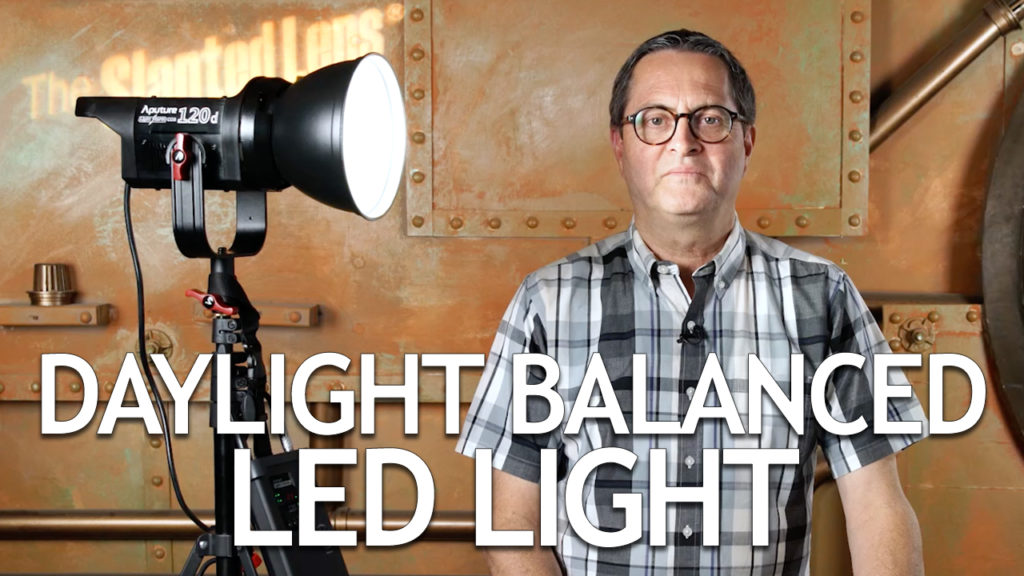Sorry your browser does not support iFrame
Hi, this is Jay P. Morgan. Today on The Slanted Lens we’re looking at the new, powerful, daylight balanced LED from Aputure, the 120d. You may remember the tungsten version of these lights from this lesson. I liked the 120t’s so much that I asked Aputure if I could have some of the daylight balanced version when they came out. I’ve been using them on set and am just as impressed with these.
Aputure 120d
Let’s start by breaking this daylight balanced LED, the 120d from Aputure, down. It’s got a Bowens mount, which is great because it matches so many modifiers. It’s got a seven-inch reflector on it right now, but there are a lot of different things we can modify the light with. We’re going to talk about a couple of those here in a second. We’ve got the head with a cable that runs into a control box. The control box is able to dial the light up and down. It’s got a battery plate, which can be used with either an Anton Bauer or V-Mount battery. So it can be run on battery or through AC.
Having the control box separate from and off the actual head is convenient because you still have access to it even if you’ve put your light up high. You don’t have to get up there and move it to try to work on the light. The control panel also has an antenna, which means that, from a remote, you can control these in groups. You can put two or three on the same channel and lower or raise the power at the same time. For instance if you have them on a backdrop, you can raise or lower them together from the remote. That’s a very useful tool.
6 Foot Test
So there’s our basic light setup for the 120d. Now let’s look at the power of this LED light. This is always what’s most important to me. Everyone has different circumstances they’re working in. Manufacturers say one thing, somebody will say another. To test this myself I get six feet away from the light, I put my ISO at 320, at a 60th of a second and then take a meter reading. On the 120d, I got 5.6 which is very powerful. I will always refer to this as my six-foot test. How much exposure do we get at 6 feet at 320 ISO? In this case, 5.6.
Fresnel Modifier
As I mentioned before, we can also modify the light. Take off the Bowens mount and put on a Fresnel adapter that Aputure also makes, and this Fresnel adapter now focuses the light. We’ve got 12 to 42 degrees. At 12 degrees, this thing is crazy bright. It has a nice center hotspot on it that’s f16. When I bring it back to 42 degrees, I get f11. So you pick up two stops with the Fresnel adapter, which is really important to know if you want a nice, focused area of light. It also gives you a ring you can put barn doors and things on, so you can modify it even further.
Now, the 120d is a single source LED, which means it’s bright and punchy, but it also means it’s pretty hard and contrasty. So you’ll really have to modify them. The CRI on this light is in the 95 range which means the color is clean, the color is good.
Why Buy the 120d?
So why is this light worthwhile? Because for $640 you get a light that is true color, powerful, and very easy to modify. The 120d is super light. It’s easy to put three or four of them in a kit that you can haul with you on location. It’s kind of the old rule of thumb with still photography- we used to have a strobe head which you then modified to do different things, hard to soft. The film industry has always been about a different light for each use. Get a light for that, get a light for this. This is one light that does all of those things. You can modify and change it and adapt it for different uses on set. So it’s a multi-use light on set at a very good price point. That’s why I like these lights.
One Very Cool Light
Just to be clear, Aputure is not a sponsor here at the Slanted Lens, but I’ve been using their light since they came out with the tungsten version, and now the daylight version on set. I love them on set. They really fulfill a need that I have there and I think you’ll find they will for you as well. So, check ’em out. So, if you have thoughts about it, if you’ve bought one of these, share them with us in the comments. Let’s hear what you’re thinking of this light and how it’s working for you on set. If you’re going to buy one, make sure you buy it through one of our affiliate links and help support new content here at the Slanted Lens.
Keep those cameras rolling. Keep on clicking.
-Jay P.

